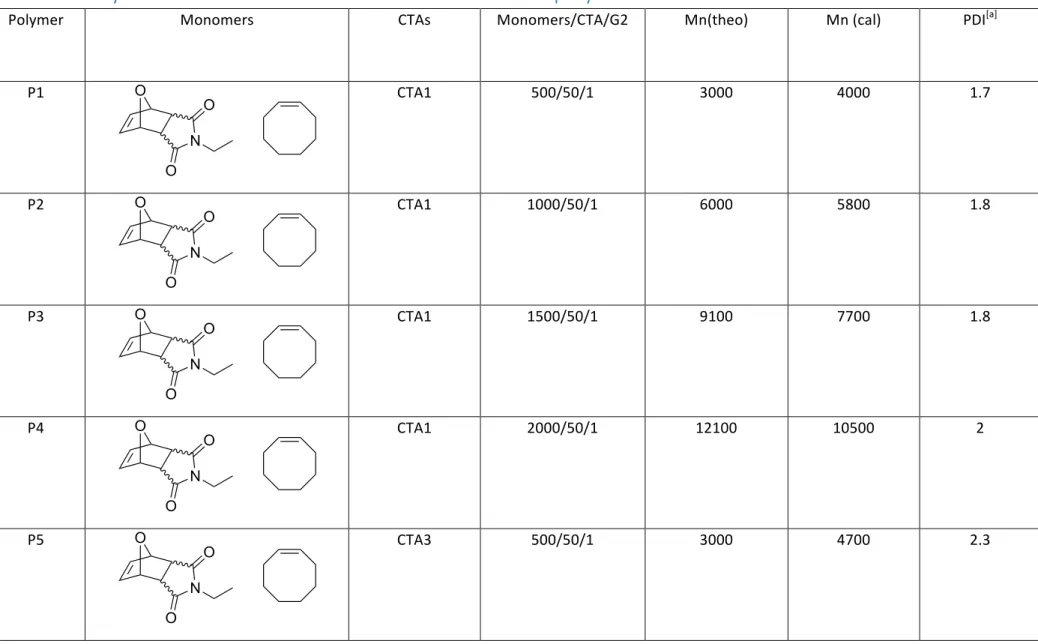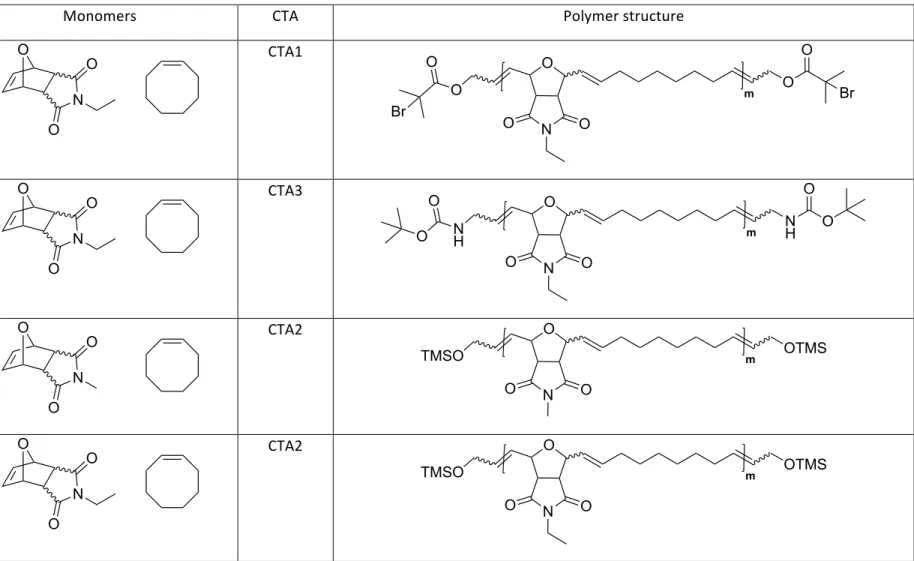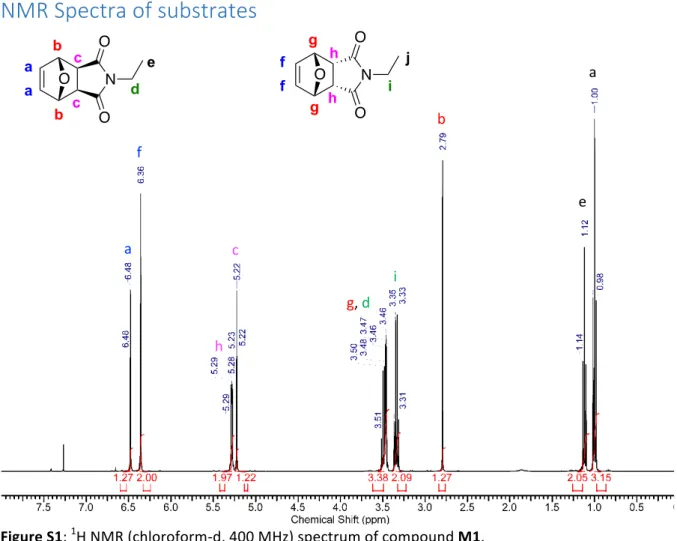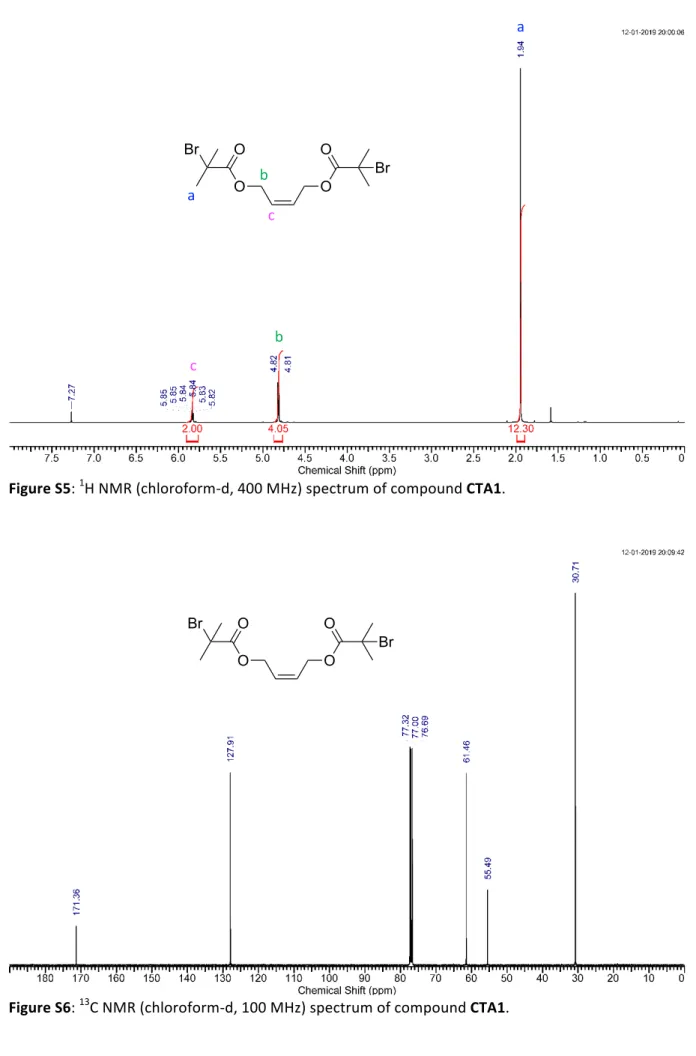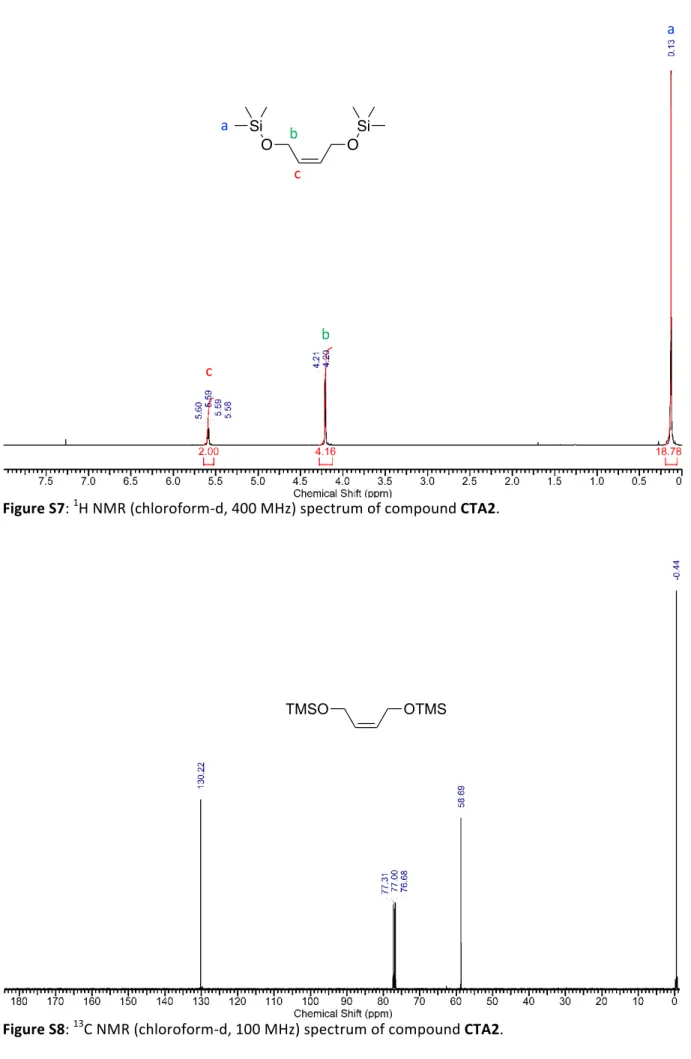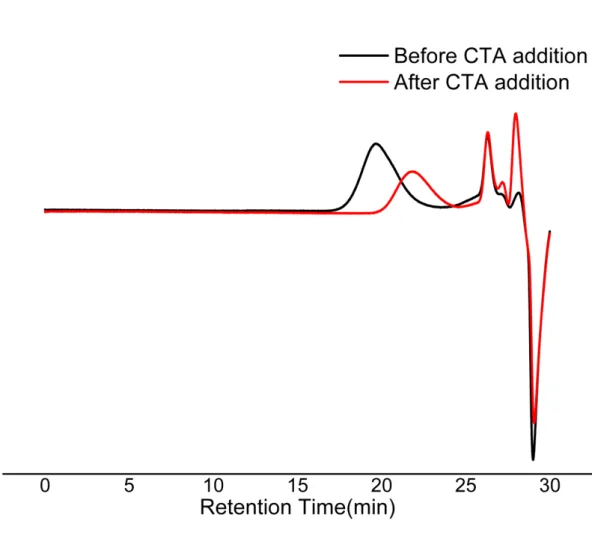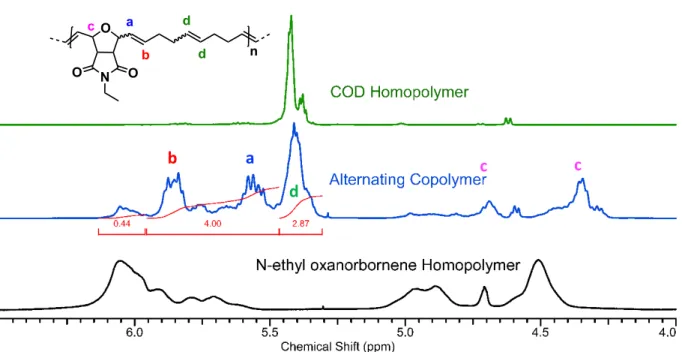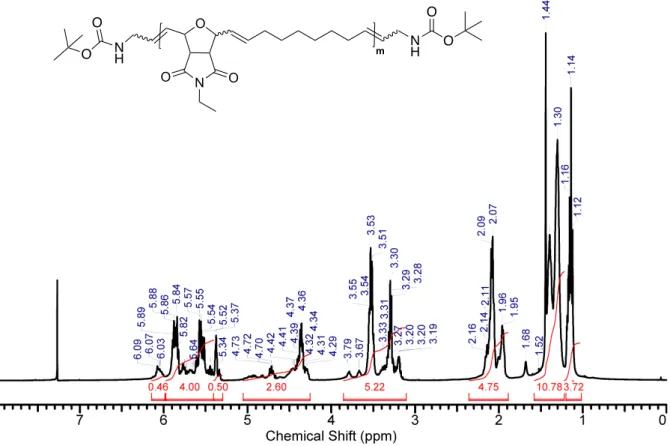Supporting Information
Telechelics Based on Catalytic Alternating Ring Opening
Metathesis Polymerization
Subhajit Pal, Mahshid Alizadeh, Andreas F.M. Kilbinger*
Department of Chemistry, University of Fribourg, Chemin du Musée 9, CH-1700 Fribourg, Switzerland.Table of Contents
MATERIALS ... 2CHARACTERIZATION ... 2
SYNTHESIS OF MONOMERS ... 3
N-ETHYLOXANORBORNENE IMIDE (OENI) (M1): ... 3
N-METHYLOXANORBORNENE IMIDE (OENI) (M2) : ... 3
SYNTHESIS OF CTAS ... 3
(Z)-BUT-2-ENE-1,4-DIYL BIS(2-BROMO-2-METHYLPROPANOATE) (CTA1): ... 3
(Z)-2,2,9,9-TETRAMETHYL-3,8-DIOXA-2,9-DISILADEC-5-ENE (CTA2): ... 4
CHAIN TRANSFER AGENTS USED FOR TERMINATION ... 4
PROCEDURE FOR POLYMER SYNTHESIS: ... 4
TABLE S1. POLYMERIZATION RESULTS AND SEC DATA FOR DIFFERENT POLYMERS ... 5
TABLE S2. SUMMARY OF POLYMERS ... 8
NMR SPECTRA OF SUBSTRATES ... 10
SEC OF POLYMERS ... 14
NMR OF POLYMERS ... 15
MALDI-TOF MASS SPECTROMETRIC DATA OF POLYMERS ... 24
TABLE S3. POLYMERIZATION RESULTS AND SEC DATA FOR DIFFERENT POLYMERS AT HIGHER TEMPERATURE.[A] ... 26
TABLE S4. EQUILIBRATION KINETIC AND SEC DATA FOR M1, COD COPOLYMERIZATION.[A] ... 27
DSC OF POLYMERS ... 28
HIGH-RESOLUTION MASS SPECTROMETRIC DATA ... 29
Materials
Grubbs initiators G2, α-bromoisobutyryl bromide, cis-2-butene-1,4-diol, Furan, N-methylmaleimide, N-ethylmaleimide, cyclooctene and cyclooctadiene were purchased from Sigma-Aldrich and used without further purification. All other reagents and solvents were purchased from Acros organics or Sigma-Aldrich and used without further purification. Di-tert-butyl but-2-ene-1,4-diyl(Z)-dicarbamate (CTA 3) were synthesized as reported previously.1 Deuterated solvents (CD2Cl2, CDCl3) were purchased from Cambridge Isotope Laboratories, Inc.
Characterization
All 1H NMR (400 MHz) and 13C NMR (100 MHz) spectra were recorded on a Bruker Avance DPX (360 MHz) FT NMR spectrometer. Chemical shifts were given in ppm relative to the residual solvent peak (CDCl3: 7.26 for 1H; CDCl3: 77.16 for 13C and CD2Cl2: 5.32 for 1H; CD2Cl2: 53.88). HR MALDI FT-ICR mass spectra were measured on a Bruker FTMS 4.7T BioAPEX II in positive mode using trans-2-[3-(tert-butylphenyl)-2-methyl-2-propenylidene]malononitrile (DCTB) as matrix and silver trifluoroacetate (AgTFA), sodium trifluoroacetate (NaTFA) as counter ion source. HR-MS (ESI+) mass spectra were measured on a Bruker FTMS 4.7T BioAPEX II and Thermo Scientific LTQ Orbitrap XL equipped with a static nanospray ion source. Relative molar masses and molar mass distributions were measured by size exclusion chromatography (SEC) with tetrahydrofuran and chloroform as eluent with a flow rate of 1 mL/min at room temperature. The THF and Chloroform SEC system was calibrated with polystyrene standards in a range from 103 to 3×106 Da. The THF SEC is an automated Viscotek GPCmax VE-2001 with a set of two Viscotek T6000M linear columns (300 x 8 mm, 5 μm particle size). Signal detection occurred by use of a Viscotek VE 3580 RI detector (refractive index). The Chloroform SEC is an automated PSS SECcurity System (Agilent Technologies 1260 infinity ll) with a set two MZ-Gel SDplus linear columns (300 x 8 mm, 5 μm particle size). Differential scanning calorimetry (DSC) analysis were performed on Mettler-Toledo STAR system at heating and cooling rate of 10 °C/min.
Synthesis of monomers
N-ethyloxanorbornene imide (OENI) (M1):
A mixture of N-ethylmaleimide (10g, 80 mmol, 1eq) and furan (8.16g, 120 mmol, 1.5eq) was dissolved in 5 mL of tetrahydrofuran. The solution was heated to 40 0C until complete disappearance of N-ethylmaleimide was observed. The reaction was concentrated under vacuum to give a white solid as 60:40 endo exo mixture (15.13g, 98%). The mixture was used for metathesis without any further purifications. Endo- isomer: 1H NMR (400 MHz, CHLOROFORM-d) δ 6.31 - 6.40 (m, 2 H), 5.25 - 5.31 (m, 2 H) ,3.41 - 3.55 (m, 2 H), 3.34 (q, J=7.21 Hz, 2 H), 1.00 (t, J=7.21 Hz, 3 H) ppm. Exo- isomer: 1H NMR (400 MHz, CHLOROFORM-d) δ 6.48 (t, J=0.92 Hz, 2 H), 5.22 (t, J=0.92 Hz, 2 H), 3.41 - 3.56 (m, 2 H), 2.79 (s, 2 H), 1.12 (t, J=7.27 Hz, 3 H) ppm.HR-MS (ESI) calcd. For C10H11NO3Na+ [M+Na]+: 216.0637; Found: 216.0627.N-methyloxanorbornene imide (OENI) (M2) :
A mixture of N-methylmaleimide (10g, 90 mmol, 1eq) and furan (9.19g, 135 mmol, 1.5eq) was dissolved in 5 mL of tetrahydrofuran. The solution was heated to 40 0C until complete disappearance of N-methylmaleimide was observed. The reaction was concentrated under vacuum to give a white solid as 57:43 endo exo mixture (15.78g, 98%). The mixture was used for metathesis without any further purifications. Endo- isomer: 1H NMR (400 MHz, CHLOROFORM-d) δ 6.39 (t, J=0.86 Hz, 2 H), 5.32 (ddd, J=2.69, 1.71, 0.86 Hz, 2 H), 3.52 (dd, J=3.61, 1.65 Hz, 2 H), 2.81 (s, 3 H) ppm. Exo- isomer: 1H NMR (400 MHz, CHLOROFORM-d) δ 6.51 (t, J=0.86 Hz, 2 H), 5.26 (t, J=0.86 Hz, 2 H), 2.97 (s, 3 H), 2.85 (s, 2 H) ppm. HR-MS (ESI) calcd. For C9H9NO3Na+ [M+Na]+: 202.0480; Found: 202.0471.Synthesis of CTAs
(Z)-but-2-ene-1,4-diyl bis(2-bromo-2-methylpropanoate) (CTA1):
Cis-2-butene-1,4-diol (5g, 56.8 mmol, 1eq) was dissolved in 20 mL of dry tetrahydrofuran. Triethylamine (12.6g, 125 mmol, 2.2eq) was added to the solution and cooled to 0 0C. To the cooled solution α-bromoisobutyryl bromide (28.73g, 125 mmol, 2.2eq) was added dropwise and was allowed to stir for overnight at room temperature. The resulting reaction mixture was filtered and concentrated under vacuum. Finally, the mixture was chromatographed on silica (hexane:EtOAc = 70:30) to give CTA1 (21g, 96%) as colorless liquid.1H NMR (400 MHz, CHLOROFORM-d) δ 5.74 - 5.91 (m, 2 H), 4.71 - 4.93 (m, 4 H), 1.95 (s, 12 H) ppm. 13C NMR (101 MHz, CHLOROFORM-d) δ 171.3, 127.9, 61.4, 55.4, 30.7 ppm. HR-MS (ESI) calcd. For C12H18Br2O4Na+ [M+Na]+: 406.9470; Found: 406.9464. O N O O O N O O + THF, 40 0C M1 O N O O O N O O + THF, 40 0C M2 O O O O Br Br OH HO Br O Br + Et3N, THF rt(Z)-2,2,9,9-tetramethyl-3,8-dioxa-2,9-disiladec-5-ene (CTA2):
A mixture of cis-2-butene-1,4-diol (2g, 22.73 mmol, 1eq) and imidazole (7.7g, 113.7 mmol, 5eq) was dissolved in 30 mL of dry dichloromethane and cool to 0 0C. To the cooled solution TMS-Cl (5.4g, 50 mmol, 2.2eq) was added dropwise. The solution was allowed to warm to room temperature and stirred overnight. Afterward, the reaction mixture was concentrated in vacuum and chromatographed on silica (hexane:EtOAc = 97:3) to obtain CTA2 (5g, 95%) as colorless liquid. 1H NMR (400 MHz, CHLOROFORM-d) δ 5.54 - 5.64 (m, 2 H) 4.14 - 4.28 (m, 4 H) 0.13 (s, 18 H) ppm. 13C NMR (101 MHz, CHLOROFORM-d) δ 130.22, 58.69, -0.44 ppm. HR-MS (ESI) calcd. For C10H24O2Si2Na+ [M+Na]+: 255.1213; Found: 255.1203.Chain transfer agents used for termination
Procedure for polymer synthesis:
An equimolar mixture of monomers (M1/M2 and COE/COD) were transfer into vials equipped with a stir bar under argon atmosphere. The required amount of CTA was added to the monomer’s mixture. Dry, degassed dichloromethane was added to the vial to obtain 1M monomer solution. Separately, a stock solution of catalyst G2 was prepared in dry, degassed dichloromethane and required amount (4 mg, 4.7 µmol) of catalyst solution was added to vials. The reaction mixture was heated for 36 hours at 40 0C under argon atmosphere. The reactions were quenched with excess ethyl vinyl ether and precipitated into cold methanol to obtain telechelic alternating polymers. OTMS TMSO OH HO+
Imidazole, DCM rt TMS-Cl OTMS TMSO O O O O Br Br NHBoc BocHNTable S1. Polymerization results and SEC data for different polymers
Polymer Monomers CTAs Monomers/CTA/G2 Mn(theo) Mn (cal) PDI[a]
P1 CTA1 500/50/1 3000 4000 1.7 P2 CTA1 1000/50/1 6000 5800 1.8 P3 CTA1 1500/50/1 9100 7700 1.8 P4 CTA1 2000/50/1 12100 10500 2 P5 CTA3 500/50/1 3000 4700 2.3 O N O O O N O O O N O O O N O O O N O
P6 CTA2 1000/25/1 11600 14900 1.7 P7 CTA2 2000/25/1 24300 23000 1.9 P8 CTA1 500/50/1 3000 4300 1.7 P9 CTA1 1000/50/1 6000 7200 2 P10 CTA1 1500/50/1 9000 10400 2 P11 CTA1 2000/50/1 12000 14700 2 O N O O O N O O O N O O O N O O O N O O O N O O
P12 CTA3 500/50/1 3000 4600 2.2 P13 CTA2 1000/25/1 11500 11800 1.9 P14 CTA2 2000/25/1 24000 26650 1.8 [a] P1-4, P8-11 were measured by THF SEC and P5-7, P12-14 were measured by CHCl3 SEC. O N O O O N O O O N O O
Table S2. Summary of polymers
Polymer Monomers CTA Polymer structure
P1-4 CTA1 P5 CTA3 P6 CTA2 P7 CTA2 O N O O O N O O O m O O O Br Br O N O O O N O O N H m N H O O O O O N O O O N O O TMSO m OTMS O N O O O N O O TMSO m OTMS
P8-11 CTA1 P12 CTA3 P13 CTA2 P14 CTA2 O N O O O N O O O m O O O Br Br O N O O O N O O N H m N H O O O O O N O O O N O O TMSO m OTMS O N O O O N O O TMSO m OTMS
NMR Spectra of substrates
Figure S1: 1H NMR (chloroform-d, 400 MHz) spectrum of compound M1. Figure S2: 13C NMR (chloroform-d, 100 MHz) spectrum of compound M1. N O O O a a b b c c d e N O O O f f g g h h i j a f c g, d i h b e a O N O OFigure S3: 1H NMR (chloroform-d, 400 MHz) spectrum of compound M2. Figure S4: 13C NMR (chloroform-d, 100 MHz) spectrum of compound M2. N O O O a a b b c c d N O O O f f g g h h i a f h c g i b O N O O
Figure S5: 1H NMR (chloroform-d, 400 MHz) spectrum of compound CTA1. Figure S6: 13C NMR (chloroform-d, 100 MHz) spectrum of compound CTA1. O O O O Br Br a a b c b c O O O O Br Br
Figure S7: 1H NMR (chloroform-d, 400 MHz) spectrum of compound CTA2. O O Si Si b a c c b a OTMS TMSO
SEC of polymers
Figure S9: SEC (THF) trace of the copolymer (monomer M1 and COE) before and after addition of CTA1.
NMR of polymers
Figure S10: 1H NMR (chloroform-d, 400 MHz) of alternating copolymer synthesis with M1 and COE. Calculated by assigning the alternating backbone as 4H and quantify the remaining homopolymer signal.a
b
c
c
O N O O n a b c Figure S11: 1H NMR (chloroform-d, 400 MHz) of alternating copolymer synthesis with M1 and COD. Calculated by assigning the alternating backbone as 4H and quantify the remaining homopolymer signal. O N O O n a b c d da
b
c
c
d
Figure S12: 1H NMR (chloroform-d, 400 MHz) spectrum of compound P1. Figure S13: 13C NMR (chloroform-d, 100 MHz) spectrum of compound P1. O N O O O m O O O Br Br d a b e c f g h h i j a b i, c d, e g, j f, h O N O O O m O O O Br Br
Figure S14: 1H NMR (chloroform-d, 400 MHz) spectrum of compound P5. O N O O N H m N H O O O O O N O O N H m N H O O O O
Figure S16: 1H NMR (chloroform-d, 400 MHz) spectrum of compound P6. Figure S17: 13C NMR (chloroform-d, 100 MHz) spectrum of compound P6. a b a O N O O O m O Si Si b O N O O TMSO m OTMS
Figure S18: 1H NMR (chloroform-d, 400 MHz) spectrum of compound P7. Figure S19: 13C NMR (chloroform-d, 100 MHz) spectrum of compound P7. O N O O O m O Si Si O N O O TMSO m OTMS
Figure S20: 1H NMR (chloroform-d, 400 MHz) spectrum of compound P9. Figure S21: 13C NMR (chloroform-d, 100 MHz) spectrum of compound P9. O N O O O m O O O Br Br a b e c f g h k j i d e, d a b c, j f g, h, k i O N O O O m O O O Br Br
Figure S22: 1H NMR (chloroform-d, 400 MHz) spectrum of compound P12. O N O O N H m N H O O O O a b e c f g h j i d k a b i c, j e, d k f O N O O N H m N H O O O O
Figure S24: 1H NMR (chloroform-d, 400 MHz) spectrum of compound P 13. Figure S25: 13C NMR (chloroform-d, 100 MHz) spectrum of compound P13. O N O O O m O Si Si a b b a O N O O TMSO m OTMS
Figure S26: 1H NMR (chloroform-d, 400 MHz) spectrum of compound P14. Figure S27: 13C NMR (chloroform-d, 100 MHz) spectrum of compound P14. O N O O TMSO m OTMS O N O O TMSO m OTMS
MALDI-ToF mass spectrometric data of polymers
Figure S28: MALDI-ToF mass spectra (DCTB, NaTFA) of P1. O N O O 3 O 3 O O O Br Br Na O N O O 4 O 2 O O O Br Br Na O N O O 3 O 4 O O O Br Br Na O N O O 4 O 3 O O O Br Br Na a b c d O N O O 3 O 5 O O O Br Br Na O N O O 4 O 4 O O O Br Br Na O N O O 5 O 3 O O O Br Br Na O N O O 4 O 5 O O O Br Br Na e f g h O N O O 5 O 4 O O O Br Br Na i a b c d e f g h iFigure S29: MALDI-ToF mass spectra (DCTB, NaTFA) of P8. a b c d e f g O N O O 3 O 3 O O O Br Br Na c O N O O 3 O 2 O O O Br Br Na a O N O O 3 O 3 O Br Na O O Br b O N O O 3 O 3 O O O Br Br d O N O O 3 O 4 O O O Br Br g e O N O O 3 O 3 O Br O O Br f O N O O 3 O 3 O Br O O Br Na
Table S3. Polymerization results and SEC data for different polymers at
higher temperature.
[a]Polymer M1: CTA: G2 Mn (theo) Mn (cal) Đ [b]
P1H 500:50:1 3000 6000 1.7 P2H 1000:50:1 6000 10000 1.8 P3H 1500:50:1 9100 15600 2 P4H 2000:50:1 12100 20000 1.8 [a] All the reactions were carried out with G2 (2 mg, 0.0024 mmol) at 60 0C for 36 hours. For entry P1H-P4H, the reactions were carried out with CTA1 (45 mg, 0.12 mmol), monomer M1 and cyclooctene (COE). [b] Measured by CHCl3 SEC. Figure S30: Dependence of observed molar mass (SEC, see Table SI1) vs. monomer (M1+COE) to CTA1 ratio at 60 0C in 1,2-dichloroethane.
Table S4. Equilibration Kinetic and SEC data for M1, COD
copolymerization.
[a]Entry M1: CTA1: G2 Mn (theo) Mn (cal) Time(hours) Đ [b]
1 2000: 50: 1 12000 18500 2 1.9 2 2000: 50: 1 12000 14800 7 2.3 3 2000: 50: 1 12000 14300 17 2.3 [a] The reaction was carried out with G2 (2 mg, 0.0024 mmol, 1eq) ,CTA1 (45 mg, 0.12 mmol, 50eq), monomer M1 (910 mg, 4.7 mmol, 2000eq) and cyclooctadiene(COD) (507 mg, 4.7 mmol, 2000eq) at 40 0C in DCM. [b] Measured by CHCl3 SEC. Figure S31: SEC (CHCl3) trace of the copolymerization of the monomer M1 and COD at different time intervals.
DSC of polymers
Figure S32: DSC data of homopolymer of M1 (second cycle from 0 0C to 300 0C).
Figure S33: DSC data of P10 (second cycle from -20 0C to 200 0C).
High-resolution mass spectrometric data
Figure S36: HR-MS of CTA1. Figure S37: HR-MS of CTA2.
